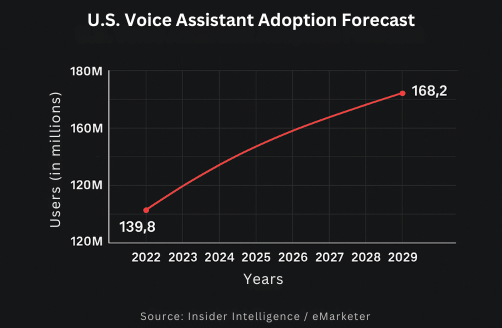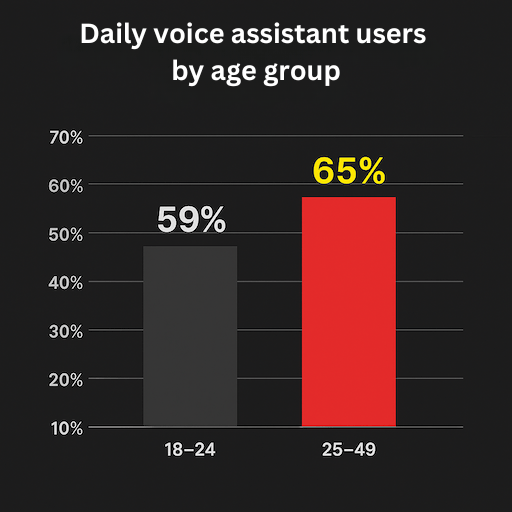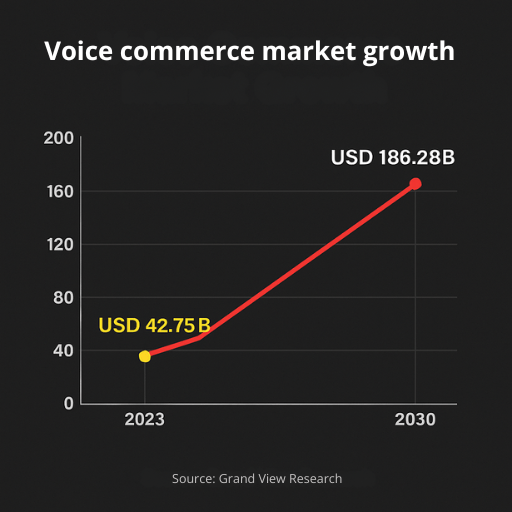Voice search isn’t just a fancy feature anymore. It’s become essential.
We ask Alexa for the latest news.
Siri helps us navigate to new places.
Google Assistant keeps track of our shopping lists.
Billions of people use billions of devices daily.
And the numbers? They’re climbing faster than ever.
Here are the latest voice search statistics shaping 2025 and beyond.
Editor’s picks
- The global voice search market is projected to grow from USD 3.86 billion in 2024 to USD 13.88 billion by 2030, at a 23.8% CAGR.
- The voice commerce market is set to expand from USD 42.75 billion in 2023 to USD 186.28 billion by 2030, growing nearly threefold in six years.
- 32% of consumers worldwide used a voice assistant in the past week as of 2025, highlighting mainstream adoption.
- In the United States, voice assistant users are forecasted to reach 154.3 million in 2025, with growth continuing to 170.3 million by 2028.
- The global voice assistant market is projected to rise from USD 7.35 billion in 2024 to USD 33.74 billion by 2030, at a 26.5% CAGR.
- The speech recognition market, the backbone of voice search accuracy, is expected to surpass USD 47 billion by 2030.
These statistics point to one simple truth: voice technology isn’t slowing down.
Market projections show massive growth across voice search, assistants, and commerce. It’s no longer just a side feature. It’s becoming the main way people interact with technology.
Consumer behavior confirms this trend. Almost a third of people globally already use voice assistants every week. In the U.S., more than half the population will be using these tools within a few years.
The tech behind it all is growing too.
Speech recognition technology – what makes voice tools accurate and natural – will likely double in size by 2030.
What does all this mean? Voice isn’t just changing how we search. It’s completely reshaping how we shop, interact, and connect with technology in our daily lives.
Sources:
- Grand View Research – Voice Search Market Report, Voice Commerce Market Report
- GWI – Voice Search Trends 2025
- Insider Intelligence / eMarketer – US Voice Assistant Users Forecast
- NextMSC – Voice Assistant Market Report
- MarketsandMarkets – Speech Recognition Market by Component & Application
Global and U.S. usage trends
- As of 2025, 32% of consumers worldwide used a voice assistant in the past week.
- Around 27% of global internet users access voice search on mobile devices.
- In the U.S., voice assistants will add approximately 30 million new users between 2022 and 2029 (growth from about 139.8 million in 2022 to 168.2 million by 2029), showing steady mainstream adoption.

- U.S. adoption means more than half of the population now interacts with voice assistants regularly.
- By 2026, voice assistant penetration in the U.S. is projected to reach 56% of internet users.
These numbers show that voice search is deeply integrated into daily life, not just a passing trend.
Globally, nearly a third of consumers use voice assistants every week. This shows how natural it has become to speak rather than type.
Over a quarter of internet users turn to voice on mobile shows its role in convenience-driven moments, like searching on the go.
In the U.S., the picture is even stronger. More than half the population already uses voice assistants, with steady growth forecasted through 2029.
This means the technology is mainstream, not niche.
For businesses, this is a clear sign: optimizing for voice is no longer optional. It’s part of meeting users where they are.
Sources:
- GWI – Voice Search Trends 2025, Voice Search Report
- eMarketer – US Voice Assistant Users Forecast, Voice Assistant Market
Device penetration and behavior
- The global voice assistant device base is forecasted to surpass 8.4 billion devices in 2024, more than the world’s population, according to Juniper Research (2020).
- In the U.S., smart speaker ownership reached 91 million adults in 2023, about 35% of the adult population.
- About 11.5% of smart speaker owners in the U.S. make a purchase using voice each month, according to Voicebot’s 2018 adoption report.
- Nearly 65% of 25–49-year-olds reported using a voice-enabled device daily in PwC’s consumer study.

- Globally, the voice assistant market is expected to grow from USD 7.35 billion in 2024 to USD 33.74 billion by 2030, showing rapid device and platform adoption.
Look around – voice-enabled devices are everywhere these days.
Billions of them are in use worldwide, making voice assistants super accessible.
Device numbers are growing faster than the population, showing how they’re becoming a normal part of phones, cars, speakers, and even watches.
In the U.S., smart speakers are in more than a third of adult homes.
Shopping with voice is still taking off, with just over 1 in 10 owners buying something monthly. But this points to where consumer habits are heading.
Age plays a big role too. The 25-49 age group uses voice tech daily the most, showing it’s deeply woven into working adults’ routines.
With the global market set to grow rapidly, it’s clear that voice assistants aren’t just gadgets anymore – they’re becoming essential tools people rely on every day.
Sources:
- Juniper Research – Voice Assistant Devices in Use to Overtake World Population
- National Public Media – Smart Audio Report 2022
- Voicebot.ai – Smart Speaker Consumer Adoption Report 2018
- PwC – Consumer Intelligence Series: Voice Assistants
- NextMSC – Voice Assistant Market Report 2024–2030
Usage patterns and satisfaction
- 32% of consumers worldwide used a voice assistant in the past week in 2025. 21% used it weekly to find information, and 20% used it to complete an action like playing music or ordering.
- In the U.S., 62% of adults use a voice assistant on any device. Among voice command users, 57% use voice daily.
- 93% of consumers reported being satisfied with voice assistants in PwC’s study.
- Americans are split on smart speakers analyzing voices to recognize who is speaking. 44% say it is unacceptable, 42% say acceptable.
- Consumers remain cautious about agentic AI making purchases. In early 2025, 66% said they would not let AI buy on their behalf, even for better deals.
Weekly use at 1 in 3 shows voice is a routine behavior, not a novelty.
The split between information lookups and action-taking suggests assistants are handling both discovery and task execution.
In the U.S., daily use among existing voice users is common, indicating mature habits.
Satisfaction levels are high, yet privacy worries persist, especially around voice analysis on smart speakers.
Consumers welcome help but still want control, which means voice experiences should emphasize transparency, opt-in features, and clear handoffs to the user.
Sources:
- GWI, “4 voice search trends and statistics to know in 2025.” (GWI)
- NPR/Edison Research via National Public Media, “The Smart Audio Report” (2022). (National Public Media)
- PwC, “Consumer Intelligence Series: The impact of voice assistants on consumer behavior” (2018). (PwC)
- Pew Research Center, “How Americans view data privacy” (2023). (Pew Research Center)
- Omnisend survey press release and coverage on AI purchasing delegation (2025). (PR Newswire, CX Dive)
Shopping and local discovery
- In the U.S., voice assistant adoption is growing steadily, with nearly 30 million new users added between 2022 and 2029.
- The voice commerce market is set to expand from USD 42.75 billion in 2023 to USD 186.28 billion by 2030, growing nearly threefold in six years.

- 76% of smart speaker users perform a local voice search at least weekly (BrightLocal)
Voice assistants are becoming commerce tools right before our eyes.
The U.S. user base is growing steadily, with tens of millions of new users expected by 2029.
When 38 million Americans were already shopping with smart speakers by 2021, it shows people feel comfortable browsing, researching, and buying just by talking.
Local search habits are even more impressive. When three-quarters of smart speaker owners search for local businesses weekly, it means voice assistants are connecting people with nearby shops and services.
What does this mean for you?
Optimizing for voice isn’t just about reaching more people. It helps you be visible when customers are ready to act.
Businesses that adapt to voice search and shopping will be in a much better position to meet this growing demand.
Sources:
- eMarketer – Voice Assistants Will Gain About 30 Million US Users (Forecast Chart)
- Grand View Research – Voice Commerce Market Report
- BrightLocal – Voice Search for Local Business Study
Accessibility and inclusion
- In 2025, 1 in 3 visually impaired internet users said they use a voice assistant weekly.
- 32% of users with physical disabilities also reported weekly use of voice assistants.
- Among visually impaired users living alone, 27% buy groceries online weekly – a rate 13% higher than the overall average.
- The speech recognition market, which underpins accessibility improvements, is projected to grow to USD 47 billion by 2030.
Voice assistants aren’t just convenient. They’re life-changing tools for people with disabilities.
For visually impaired and physically disabled users, these weekly usage rates show how essential voice technology has become for independent living.
Think about it: visually impaired people living alone are ordering groceries at rates 13% higher than average.
That’s not just a statistic. It’s freedom.
The big tech companies are taking note too. Apple, Google, and Microsoft now build voice features directly into their systems. Screen readers, dictation, voice navigation – these aren’t special add-ons anymore. They’re standard features that help millions of people.
And with speech recognition technology growing into a $47 billion market by 2030, we can expect even better accuracy and more inclusive features.
This is where voice technology truly shines. It’s not just about faster searching or hands-free convenience.
It’s about giving people control over their digital and daily lives.
Sources:
- GWI – 4 voice search trends and statistics to know in 2025
- MarketsandMarkets – Speech Recognition Market by Component & Application
Conclusion
Voice technology is firmly established as a mainstream habit. With one in three consumers worldwide using voice assistants weekly, and U.S. adoption crossing half the population, it is no longer an emerging trend. It is the norm.
The markets behind voice are scaling at speed. Voice search, assistants, and commerce are all projected to multiply in size by 2030, with revenues in the hundreds of billions. This growth reflects not just more devices, but deeper integration across daily tasks, shopping, and information-seeking.
Shopping and local discovery stand out as two of the strongest use cases. From ordering groceries to finding “near me” businesses, voice bridges digital and physical worlds seamlessly.
Accessibility is another key driver. For visually impaired or physically disabled users, voice is more than convenience – it’s independence. Rising adoption among these groups underscores the technology’s social impact.
The overall picture is clear: Voice assistants are evolving into essential infrastructure.
Businesses and organizations that don’t adapt their strategies for voice-friendly search, services, and commerce risk being left behind as consumer expectations shift toward speaking rather than typing.




